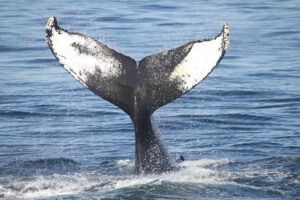
I recently visited the blue whales in the Sea of Cortez near Loreto, Mexico. These majestic mammals, the largest among us, are 85 feet long. They are an endangered species. There used to be 250,000 of them. Now only 10,000 or so remain. Their diet entirely consists of krill, tiny shrimp-like creatures. Due to their size, they each need to eat six tons of krill a day. Fortunately, there are still lots of krill found in the Sea of Cortez. Krill eat plankton.
As reported by Renee Cho in the State of the Planet newsletter from the Columbia Climate School, plankton, which are the basis of much of the food chain in our oceans, are threatened by climate change. Overheating and excess carbon affect plankton growth. Plankton is critical to our carbon cycle. When plankton die some of the carbon they take in through photosynthesis sinks into ocean depths and is sequestered from the atmosphere. That process makes the ocean the earth’s largest carbon sink. It is estimated that oceans have absorbed about 40% of all the carbon dioxide humans have put into the atmosphere since the industrial revolution. Cho reports that climate models project that warming temperatures will alter ocean currents reducing the nutrients that well up from the deep ocean resulting in fewer plankton, thus affecting the ocean’s ability to sequester carbon. Some studies even suggest that warming temperatures can change plankton from carbon absorbers to carbon emitters. And as temperatures rise, circulation patterns change.
As oceans warm, species must adapt, migrate, or go extinct. As Cho reports, we’ve already seen the significant effects caused by a plankton decrease of 65% in the Gulf of Maine off the coast of New England as the waters have become warmer and saltier over the last 20 years.
The Australian National Science Agency, CSIRO, studies how climate change will affect future krill abundance and whale populations, particularly blues, minkes, humpbacks and fin whales. All baleen whales depend on stable environmental conditions and need massive amounts of krill. And krill need reliable sources of plankton. Plankton are at the mercy of changing currents and climate change.
I also saw a lot of humpback whales. These giants are 55 feet long. We are learning that they have complex languages that share certain aspects of human language. As Katherine Latham reported recently in bbc.com, scientists are slowly learning to speak whale. In 2021 a research vessel sent a recording of a humpback greeting call through a speaker. They were stunned when one of the humpbacks responded in a conversational manner for some twenty minutes. Of course we have yet to translate what it was saying.
A recent New York Times article by Amily Anthes discussed how the Humpback songs share structural patterns with human language. “Male humpback whales sing long elaborate songs that are composed of a variety of sounds strung together with repeated phrases or themes. That song evolves over time, sometimes gradually and sometimes all at once,” Anthes reported. Scientists believe these phrases are analogous to words. Anthes points out that both whale and human languages are culturally transmitted and passed down over generations.
Extensive research into the language of whales, dolphins and other species is demonstrating that language is a common behavior. Latham also reports that a group of artificial intelligence and natural language processing experts, cryptographers, marine biologists, robotic experts and underwater acousticians are working on using AI to decipher sperm whale conversations. Some researchers think it may be possible to break the code within five to 10 years. Sperm whales have the largest brains of any animal. They gather in family groups and communicate using a morse code-like sequence of clicks known as codas. This project is led by marine biologist David Gruber. As Gruber says, “It’s difficult for us to peer into their world other than these brief interactions at the surface. This is a unique gentle creature and there’s just so much going on. Each time we look, we find deeper complexity and structure in their communication. The goal is to create a conversation using the sperm whale’s own vocalizations.”
AI may someday help us communicate with many other species. And what will we finally say to each other if we can break the code? Will we tell them we’re sorry that we changed the climate and now threaten their very existence. And how will they respond? Will the humpbacks add a new sorrowful song to their repertoire?
Published on March 23, 2025, in the Albuquerque Journal.
© Judith Polich. All Rights Reserved. May be republished with author’s written consent and proper attribution.
